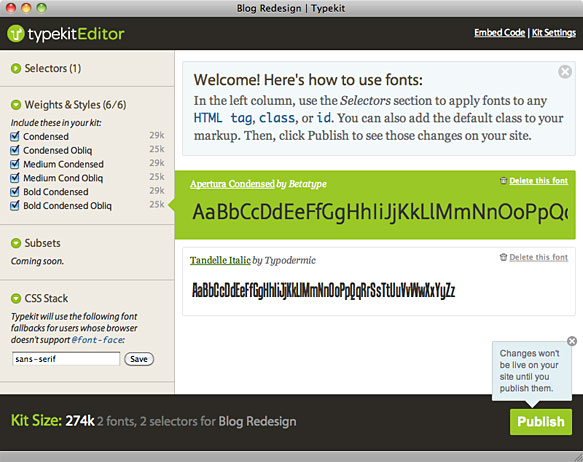For the last few weeks or so I’ve had the opportunity to tinker with the technology preview (beta) of Typekit. It’s been quietly in use on this site since the end of August.
Designers such as myself have wanted the ability to use real fonts on the web for years without the hair-pulling, potential accessibility and licensing issues of image replacement, sIFR, Cufon or other “hacks” (however clever, they’re still hacks — deal with it). We’ve also wanted to ensure type designers and distributors get paid appropriately so they can keep creating and making available great typefaces.
Typekit, as with other upcoming services such as Kernest and those from Ascender and Typoteque make this possible now by essentially levelling the playing field across browsers, providing pain-free implementation mechanisms and protecting designers from the messy business of licensing issues and ethical ramifications of distributing raw font files to browsers.

So, what’s so good about Typekit? Why should designers care?
The Good
- More fonts Specify fonts in CSS font stacks beyond the most commonly available fonts. Yay!
- Creating Kits is easy Creating a “kit” — a selection of fonts, is simple and for the most part feels familiar; not unlike using a desktop font manager.
- Easy to implement If you’ve used sIFR or had to deal with image-replacement techniques, you know how frustrating they can be. With Typekit, just add the Javascript code provided as part of a kit to your pages. The rest is just a matter or specifying fonts in your CSS as you would normally.
- Browser support Through a little bit of magic Typekit works across platforms and browsers — even IE6. Personally I would be totally Ok if Typekit didn’t suppose IE6 (or even IE7) but it does so they get bonus points from me for being comprehensive.
- Is a good Javascript citizen The Javascript used by Typekit, at least in my experience so far behaves well and doesn’t inadvertently stomp on other Javascript events.
- Reliable The service itself seems like it was designed to scale from the start. By using a Content Delivery Network (CDN) instead of a centralized server, the service should be able to withstand very high loads, provide low latency and easily maintain 100% uptime which is appropriate for such a service.
The Less Good
Even though Typekit is a great service that will only get better with time, and although my experience using it has been flawless, there’s still room for improvements. The following would be on my list.
- Even more fonts This is a no-brainer obviously. There’s a huge minefield of licensing and IP issues to sort out and understandably that takes time. The biggest issue with the fonts available now — which are largely from smaller foundries and independent type designers is probably that most designers don’t already have their own personal licences to use in comps or outside a browser.
- Browsing is awkward Finding the right font to add to a kit can be tedious. Right now the only options for locating fonts is browsing the paginated listings or using the classification/tag filters. Adding the ability to browse alphabetical pages, additional categorizations or a more traditional search interface might help.
- Weights and styles It’s not obvious what weights and styles are available for a given font unless you view the detail page for the font or add it to a kit and look at the Weights & Styles tab. Indicating the number of weights and styles in the listings would be a good place to start.
- New additions Right now if new fonts are added to Typekit, there’s no obvious way for users to find them other than by browsing through the listings or perhaps by a mention in the Typekit newsletter. Without any inside knowledge it’s hard to speculate how often new fonts will be added to the service but I think it’s safe to assume new fonts will be added with some degree of regularity.
- Requires Javascript This really isn’t a big issue in my opinion because for anyone that’s disabled Javascript in their browser likely wouldn’t know what they’re missing anyway.
My gut feeling is that Typekit will ultimately be a stop-gap solution, but one that will keep up with the current momentum of browser vendors, distributors, and type designers who are ready to start licensing fonts to be used on the web so long as everything is licensed properly and intellectual property rights are protected. If they can make it easy, affordable and reliable, I have no doubt it’ll do well and be around for a long time.
Additional Reading/Listening
For some background and detailed context on the concerns from both sides of the fence (type users, type designers/distributors), I highly recommend checking out the recording of the Web Fonts Panel from the ‘09 TypeCon conference.
Get Your ‘Kit On
I’ve got 5 beta invitations for Typekit and if you’d like to get your hot little hands on one, send an email to typekit@ this domain and I’ll hook you up.